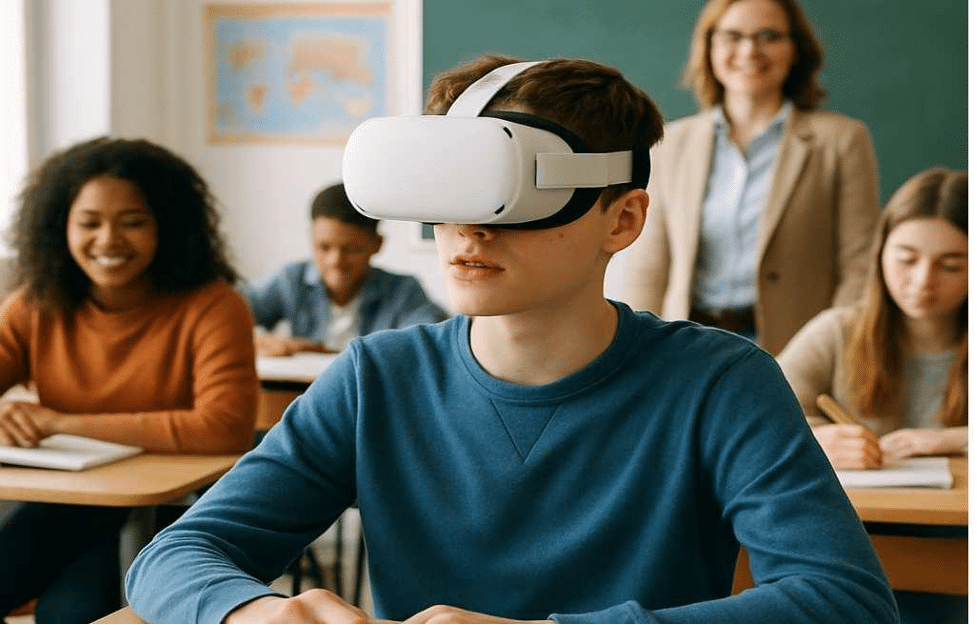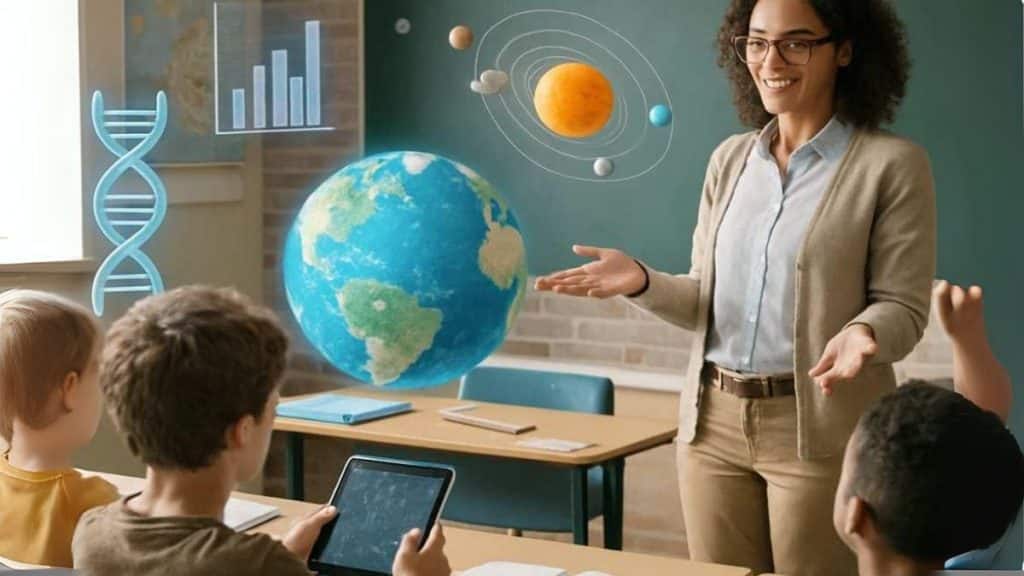The evolution of educational technology is on the cusp of a major revolution with the integration of augmented reality (AR), virtual reality (VR), and virtual reality training. This shift promises to transform how we perceive and experience educational environments, making them more interactive, immersive, and adaptive.
Imagine a platform where lifelike 3D holograms of teachers and students interact seamlessly in a shared virtual classroom. This environment is enhanced by AI-powered translation, real-time emotion recognition, and adaptive lesson pacing. It’s an ambitious vision—but one that could fundamentally redefine the future of education.
The technological advancements in educational technology (EdTech) are rapidly changing the way educational content is delivered. These innovations emphasize interactive learning experiences, where engagement and interaction are at the forefront. The integration of AR and VR into education platforms is a significant leap forward in this direction.
Interactive Learning Experiences
Interactive learning experiences foster deeper understanding and retention of knowledge. AR and VR education platforms can simulate real-world scenarios, providing students with practical experiences that traditional classrooms cannot offer. For instance, medical students can perform virtual surgeries, and history students can walk through ancient civilizations, all within a virtual space.
The Psychology of Immersive Learning
Incorporating insights from cognitive science, the psychology of immersive learning illustrates why AR and VR experiences significantly enhance educational outcomes. Here’s how these immersive methods benefit learning:
Multisensory VR/AR and Memory Retention
Research shows that multisensory experiences can boost memory retention by up to 75% compared to traditional learning methods. When learners engage multiple senses, they create stronger neural connections, leading to improved recall and understanding.
Presence and Embodiment Theory
3D holograms facilitate a sense of presence and embodiment, fostering stronger bonds between teachers and students. This immersive interaction helps students feel more connected and engaged, enhancing the overall learning experience.
Emotional Engagement as a Driver of Learning Success
Emotional connections play a crucial role in learning. Immersive environments promote emotional engagement, making learners more invested in their education. This heightened emotional state can drive motivation and ultimately lead to better learning outcomes.
Reduced Cognitive Load Through Immersive Contextualization
Immersive learning contexts help reduce cognitive load by placing information within relatable and engaging scenarios. This contextualization enables learners to process information more easily, enhancing comprehension and retention.
By leveraging the principles of cognitive science, the AR VR education platform not only enhances the learning experience but also establishes a compelling rationale for the effectiveness of immersive learning methods in education.
The Imperative of AR and VR in Education
Augmented reality and virtual reality are not just buzzwords; they are powerful tools that can significantly enhance learning. AR overlays digital content on the physical world, while VR immerses the user in a completely virtual environment. Both technologies can create rich, multisensory experiences that make learning more engaging and effective.
Designing the AR VR Education Platform
The design of an AR VR education platform must focus on creating a lifelike and engaging environment. The goal is to make learning as interactive and realistic as possible, drawing on the strengths of both AR and VR technologies.
Platform Architecture and Technology Stack
In developing an advanced AR VR education platform, showcasing the underlying technology stack is crucial to attract developers, investors, and tech media. The architecture is designed to support real-time interactions, seamless user experiences, and integration of advanced features. Here are the key components:
Real-time 3D Rendering
- Unity3D and Unreal Engine: These robust game engines are essential for creating high-quality graphics and immersive environments. They allow for the development of lifelike simulations and interactions within the virtual classroom.
- WebXR Options: By leveraging WebXR, the platform can provide accessible VR and AR experiences directly through web browsers, enabling wider accessibility without the need for dedicated applications.
Hologram Capture Technologies
- Volumetric Video Techniques: This technology captures physical subjects in three dimensions, enabling the creation of realistic holograms that can interact within the virtual environment.
- AI-based Avatar Generation: Utilizing AI, avatars can be dynamically created to represent students and teachers, ensuring diverse and personalized digital presences in the classroom.
Cloud-Based AI Services
- Translation Technologies: Integrating cloud services like OpenAI and Azure AI allows for real-time language translation, supporting a multicultural learning environment.
- Emotion Recognition Services: By employing advanced APIs such as AWS Rekognition, the platform can analyze users’ emotions through their facial expressions and body language.
Edge Computing Solutions
- Latency Reduction in VR Classrooms: Edge computing ensures that data is processed closer to the user, reducing latency and enhancing the responsiveness of interactions in the virtual environment.
Ensuring Cross-Device Compatibility
- The platform must support various devices, including AR glasses, VR headsets, tablets, and PCs, to provide seamless access and experiences to all users, making education more inclusive and flexible.
By leveraging this comprehensive technology stack, the AR VR platform aims to create a cutting-edge educational experience that is engaging, interactive, and accessible to all learners.
Lifelike 3D Holograms
The use of lifelike 3D holograms can significantly enhance the feeling of presence and interaction in a virtual classroom. Teachers and students appear as 3D avatars, allowing for natural gestures and expressions, thus bridging the gap between physical and digital interactions. This level of realism is crucial in maintaining engagement and facilitating effective communication.
AI-Powered Translation
Language barriers can hinder learning in a global classroom. AI-powered translation can provide real-time language translation, allowing students and teachers from different linguistic backgrounds to communicate seamlessly. This feature not only broadens the reach of education but also promotes inclusivity and diversity in learning environments.
Emotion Recognition
Understanding student emotions is key to effective teaching. Emotion recognition technology can analyze facial expressions and body language to gauge student engagement and comprehension. This data enables educators to tailor their teaching methods and provide personalized support to each student, fostering a more effective learning experience.
Adaptive Lesson Pacing
Every student learns at their own pace. Adaptive lesson pacing technology uses AI to adjust the speed and complexity of lessons based on individual student performance. This personalized approach ensures that each student receives the appropriate level of challenge and support, optimizing the learning experience.
Teacher Tools and Administrative Dashboard
In the AR VR education platform, addressing the needs of educators is as vital as enhancing student experiences. The Teacher Tools and Administrative Dashboard are designed to empower teachers with the necessary resources to facilitate effective classroom management and deliver personalized instruction. Here are the core components:
Virtual Classroom Management Panel
- A comprehensive interface where educators can oversee the virtual classroom environment. This panel includes functionalities for managing student avatars, controlling lesson flow, and coordinating interactions among participants, ensuring a structured and focused learning experience.
AI-Driven Assessment and Progress Tracking
- Tools that leverage AI to assess student performance and track academic progress in real-time. These systems provide educators with insights into individual and collective student achievements, enabling timely interventions and tailored support to enhance learning outcomes.
Real-Time Emotion and Engagement Analytics Dashboard
- This dashboard presents live data on student engagement levels and emotional responses during lessons. By analyzing facial expressions and interaction patterns, educators can gauge attention and adjust their teaching strategies accordingly, fostering a more responsive learning environment.
Customizable Lesson Modules and Adaptive Content Controls
- Features that allow teachers to create and modify lesson plans based on class needs. Educators can adapt content to suit different learning styles, integrate additional resources, and personalize lessons, making learning more relevant and engaging.
Scheduling, Attendance, and Classroom Behavior Insights
- Administrative tools that streamline scheduling and attendance tracking. Educators can easily monitor class participation and behavior trends, providing valuable insights that inform classroom management strategies and enhance overall educational effectiveness.
By equipping teachers with these tools, the AR VR education platform ensures that they have the resources and data needed to support students effectively, driving better educational outcomes and overall classroom success.
Real-World Applications and Implications

The potential applications of an AR VR education platform are vast and varied, offering transformative possibilities across different educational sectors.
Immersive Training Simulation
In fields requiring hands-on experience, such as medicine, engineering, and aviation, VR Employee Training provides a safe and controlled environment for practice. Students can perform complex procedures and operations without the risk of real-world consequences, allowing for repeated practice and mastery of skills.
Augmented Reality Education in Classrooms
Augmented reality can bring static educational materials to life. Textbooks and worksheets can be enhanced with AR content, providing interactive elements that deepen understanding. For example, a biology textbook could feature AR animations of cellular processes, making abstract concepts tangible and accessible.
Partnerships and Industry Collaboration
To position the AR VR education platform as an integral part of the global EdTech ecosystem, establishing strategic partnerships and collaborations is essential. Here’s how these alliances can enhance the project’s credibility and impact:
Collaborations with VR Studios
One key approach is collaborating with VR studios and companies that offer custom VR development services, bringing technical expertise and immersive content creation capabilities to the platform. This ensures that the interactive educational experiences are engaging, realistic, and aligned with the latest VR standards.
Additionally, partnerships with universities and colleges can provide invaluable insights and resources. Such collaborations facilitate pilot programs, curriculum integration, and iterative feedback from educators and students—ensuring the platform meets both academic standards and pedagogical needs.
VR Hardware Providers
Working with leading VR hardware manufacturers can enhance the platform’s capabilities and ensure compatibility with state-of-the-art equipment. This partnership can also facilitate access to cutting-edge technology that enriches the overall learning experience.
AI Labs and Technology Firms
Collaborations with AI research labs can drive innovation in features like emotion recognition and language translation. Partnering with tech firms ensures that the platform remains at the forefront of technological advancements, benefiting from the latest developments in AI and machine learning.
Open-Source APIs for Educational Content Creators
By offering open-source APIs, the platform encourages third-party developers and educational content creators to contribute. This collaborative approach can lead to a rich library of diverse learning materials, making the platform more versatile and appealing to a broader audience.
Research Partnerships on VR Learning Effectiveness
Engaging in research partnerships can validate the platform’s effectiveness in enhancing learning outcomes. Collaborating with educational researchers allows for empirical studies on the impact of immersive learning, reinforcing the platform’s credibility within the educational community.
By fostering these partnerships and collaborations, the AR VR education platform can establish itself as a key player in the EdTech landscape, driving innovation and enhancing the overall educational experience for learners worldwide.
Challenges and Considerations
While the potential of AR and VR in education is immense, there are challenges to consider.
Technical and Financial Barriers
Implementing AR and VR technologies requires significant technical infrastructure and investment. Schools and institutions must be equipped with the necessary hardware and software, which can be cost-prohibitive, especially in underfunded regions.
Ensuring Accessibility
Accessibility is a critical concern. Educational platforms must ensure that AR and VR content is accessible to all students, including those with disabilities. This requires thoughtful design and consideration of diverse user needs.
Data Privacy and Security
The use of AI and emotion recognition raises concerns about data privacy and security. It is crucial to implement robust measures to protect student data and ensure that privacy is maintained in virtual learning environments.
Conclusion
The design of an AR VR platform for education is a pioneering step towards the future of learning. By harnessing the capabilities of lifelike 3D holograms, AI-powered translation, emotion recognition, and adaptive lesson pacing, this platform promises to create an immersive, inclusive, and personalized learning experience. As we navigate the challenges and embrace the opportunities, the integration of AR and VR in education holds the promise of making learning more engaging, effective, and accessible for students around the world.
The journey towards this revolutionary platform is just beginning, and it calls for collaboration, innovation, and commitment from educators, technologists, and policymakers alike to realize its full potential.


